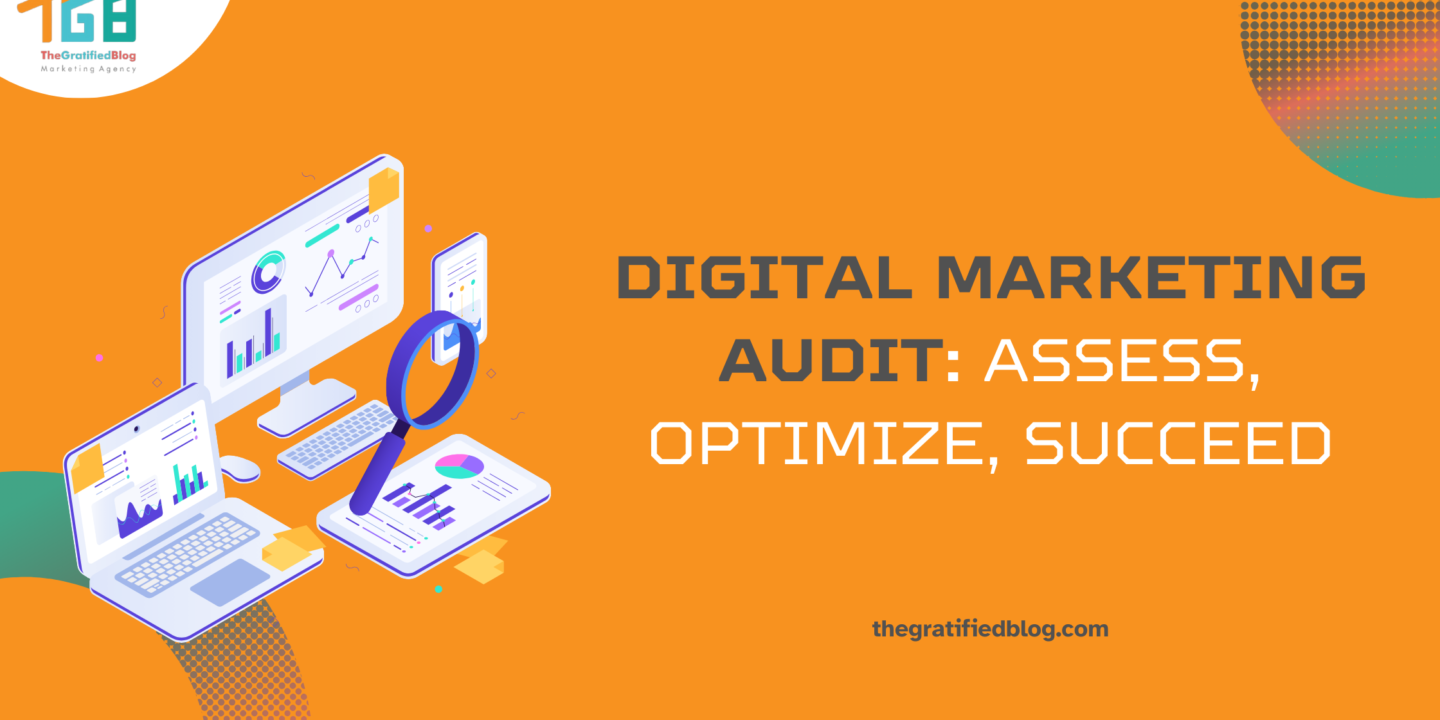
Staying ahead in today’s fast-changing competitive landscape digital environment entails more than simply running marketing campaigns. It entails a strategic approach that involves constant evaluation, optimization, and adaptation. This is where the concept of a “digital marketing audit” comes into play.
A digital marketing audit thoroughly evaluates a business’s digital marketing efforts and channels. It delves into website performance, social media presence, email marketing effectiveness, paid advertising ROI, and overall digital strategy alignment with business goals.
This article will explore the details of conducting a digital marketing audit, its benefits, key components, best practices, and how businesses can leverage audit insights to drive growth and success in the digital realm.
So, let’s dive into it:
Understanding Digital Marketing Audits And Their Significance
A digital marketing audit systematically evaluates a company’s digital marketing strategies, channels, and performance metrics. It involves analyzing various digital marketing endeavours to pinpoint strengths, weaknesses, opportunities, and threats.
The aim is to gain actionable Insights that can be utilized for campaign optimisation, improve ROI, and align marketing strategies with business objectives.
Importance of conducting regular audits
The importance of conducting regular digital marketing audits cannot be overstated, especially in today’s competitive digital landscape. Here are some key reasons why regular audits are essential:
- Performance Evaluation: Audits help assess the effectiveness of current digital marketing initiatives. By examining numbers like the number of people visiting the website and the number who actually buy something, social media engagement, email open rates, and PPC campaign performance, businesses can gauge the effectiveness of their strategies.
- Identifying Gaps and Opportunities: Audits reveal gaps in strategies or missed opportunities that could hinder business growth. For example, an audit might uncover untapped audience segments, underperforming keywords, or inefficient ad placements, prompting adjustments for better results.
- Optimising Budget Allocation: Businesses can allocate their digital marketing budgets more effectively by understanding which channels and campaigns yield the highest ROI. This prevents wasteful spending on strategies that aren’t delivering results and reallocates resources to high-performing areas.
- Staying Competitive: In the ever-evolving digital landscape, staying competitive requires continuous improvement. Regular audits help businesses stay updated with industry trends, adopt best practices, and adopt emerging strategies to remain relevant and competitive.
- Enhancing Customer Experience: Audits often include assessing the user experience on websites, mobile apps, and social media platforms. Improving the customer journey based on audit findings can increase satisfaction, engagement, and loyalty.
- Compliance and Risk Management: Audits can uncover compliance issues related to data privacy, advertising regulations, and industry standards. Addressing these issues proactively mitigates legal penalties, reputational damage, and customer trust risks.
Now that we’ve covered what a digital marketing audit is and why it’s crucial let’s explore its components.
Components Of A Digital Marketing Audit

Here are the components of a digital marketing audit, along with specific areas to assess under each element:
Website Audit
- User experience analysis: Evaluate website navigation, load times, mobile responsiveness, and overall ease of use for visitors.
- SEO performance evaluation: Review keyword rankings, organic traffic trends, backlink profiles, and on-page optimisation factors.
- Content quality assessment: Analyze the relevance, accuracy, freshness, and engagement levels of website content, including blog posts, articles, and multimedia.
Social Media Audit
- Platform analysis (Facebook, Twitter, LinkedIn, etc.): Assess the presence, activity, and performance on each social media platform, including follower growth, post frequency, and audience demographics.
- Engagement metrics review: Measure likes, shares, comments, retweets, and other engagement metrics to gauge audience interaction and content resonance.
- Content relevance and effectiveness: Evaluate the effectiveness of social media content in driving brand awareness, engagement, conversions, and customer satisfaction.
Email Marketing Audit
- Subscriber list health check: Review subscriber growth rates, list segmentation, email deliverability, and unsubscribe rates to ensure a healthy and engaged email audience.
- Email campaign performance evaluation: Analyze open rates, click-through rates (CTR), conversion rates, A/B testing results, and email automation effectiveness.
- Compliance with legal regulations (GDPR, CAN-SPAM Act): Ensure email marketing practices align with pertinent data protection and anti-spam regulations to maintain trust and avoid penalties.
Paid Advertising Audit
- PPC campaign review: Evaluate the performance of pay-per-click (PPC) campaigns on platforms like Google Ads, Bing Ads, and social media ads regarding impressions, clicks, cost per click (CPC), and conversion rates.
- Ad performance analysis (CTR, conversion rates, ROI): Measure ad click-through rates, conversion rates, return on ad spend (ROAS), and overall campaign ROI to assess advertising effectiveness.
- Budget allocation assessment: Review budget allocation across advertising channels and campaigns to ensure optimal resource allocation and ROI maximization.
Analytics And Reporting Audit
- Tracking setup verification (Google Analytics, etc.): Confirm that analytics tools are correctly set up to accurately track relevant metrics, goals, events, and conversions.
- Key performance indicators (KPIs) assessment: Evaluate performance against critical digital marketing KPIs such as traffic sources, conversion rates, customer acquisition cost (CAC), and customer lifetime value (CLV).
- Custom reporting analysis: Customize reports to extract actionable insights, trends, patterns, and recommendations for optimising digital marketing strategies and tactics.
Now that you understand the importance of each component in evaluating and improving various aspects of a company’s digital marketing efforts let’s delve into the strategy for conducting a digital marketing audit.
How To Perform Digital Marketing Audit?

Performing a digital marketing audit involves a structured approach to assess various aspects of a company’s digital marketing efforts. Here are five steps to guide you through the process:
- Define Audit Objectives and Scope: Start by clearly defining the objectives of the audit and the scope of areas to be evaluated. Identify key performance indicators (KPIs) and metrics relevant to your business goals, such as increasing website traffic, improving conversion rates, enhancing brand visibility, or optimizing marketing spend. Determine which digital channels and strategies will be included in the audit, such as website, social media, email marketing, paid advertising, and analytics platforms.
- Gather Data and Information: Collect comprehensive data and information related to each audit component. This may include analytics reports, website performance metrics, social media analytics, email campaign data, advertising spending and performance data, customer feedback, competitor analysis, and industry benchmarks. Use a combination of tools and platforms such as Google Analytics, social media analytics tools, email marketing platforms, advertising dashboards, and industry research reports to gather relevant data.
- Conduct Analysis and Evaluation: Analyze the collected data to evaluate digital marketing strategies’ performance, effectiveness, and alignment with business objectives. Identify trends, patterns, strengths, weaknesses, opportunities, and threats across each digital marketing component. Analytical tools, metrics, and benchmarks assess performance against industry standards, competitor benchmarks, and internal goals. Consider qualitative factors such as brand perception, customer sentiment, and market trends in your analysis.
- Produce insights and make recommendations: Based on the analysis and evaluation, generate actionable insights and recommendations for improvement. Prioritise recommendations based on impact, feasibility, and resource allocation. Provide specific and actionable recommendations for optimizing digital marketing strategies, addressing weaknesses, leveraging strengths, and capitalizing on opportunities. Consider cross-functional collaboration with marketing, sales, IT, and other departments to implement recommended changes effectively.
- Create an Action Plan and Implementation Roadmap: Develop a comprehensive action plan and implementation roadmap based on the audit’s insights and recommendations. Define clear goals, timelines, responsibilities, and success metrics for each action item. Allocate resources, budget, and technology requirements for implementing changes and improvements identified in the audit. Monitor progress regularly, track key performance indicators (KPIs), and modify strategies to attain the desired results and continuous improvement.
By following these steps, businesses can effectively perform a digital marketing audit, gain valuable insights, and drive strategic improvements in their digital marketing strategies and tactics.
Now, let’s discuss the tools used for conducting a digital marketing audit and the recommended practices for performing such an audit.
Tools And Techniques For Conducting A Digital Marketing Audit
Here’s an explanation of each tool category for conducting a digital marketing audit:
Free Tools For Website Analysis (e.g., Google Analytics, Google Search Console):
- Google Analytics: It provides comprehensive website performance data, such as traffic sources, user behaviour, conversion rates, and campaign tracking. It helps identify strengths and weaknesses in website traffic, user engagement, and conversion funnels.
- Google Search Console: Focuses on SEO performance by providing insights into search visibility, keyword rankings, organic traffic, and website indexing issues. It helps optimize website content, improve search engine rankings, and address technical SEO issues.
Paid Tools For In-Depth Audits (e.g., SEMrush, Moz, Ahrefs):
- SEMrush: Offers competitive analysis, keyword research, backlink analysis, PPC insights, and site audit features. It provides detailed data on competitors’ strategies, keyword opportunities, and overall website health for comprehensive audits.
- Moz: Focuses on SEO analysis with features like site crawl, keyword rankings, backlink analysis, and on-page optimization recommendations. It also offers local SEO tools and competitive analysis for deeper insights.
- Ahrefs: Specializes in backlink analysis, keyword research, content analysis, and rank tracking. It helps identify link-building opportunities, analyze competitor backlink profiles, and track keyword performance across search engines.
Best Practices For Interpreting Audit Results

- Prioritizing actionable insights: Focus on identifying insights that can directly impact digital marketing strategies and tactics. Prioritize actionable recommendations that are feasible, impactful, and aligned with business goals. This includes addressing urgent issues, optimizing high-impact areas, and leveraging opportunities for improvement. By prioritizing actionable insights, businesses can allocate resources effectively and implement changes that drive tangible results.
- Identifying strengths and weaknesses: Identify and acknowledge areas of strength and weakness across different digital marketing components. Recognize what is working well and capitalize on strengths to maximise results. Simultaneously, address weaknesses and areas for improvement to enhance overall performance. Understanding strengths and weaknesses provides a balanced perspective and guides strategic decision-making for optimization efforts.
- Benchmarking against industry standards: Compare audit results against industry benchmarks, best practices, and competitor performance metrics. Benchmarking helps assess performance relative to industry standards and identify areas where improvements can be made to align with or surpass industry norms. It provides valuable context and insights into how well digital marketing efforts compare to peers and market leaders.
- Collaborating with cross-functional teams for improvement strategies: Engage cross-functional teams, including marketing, sales, IT, customer service, and management, in interpreting audit results and developing improvement strategies. Collaborative efforts ensure the alignment of goals, perspectives, and resources across departments. It also fosters idea-sharing, innovation, and collective problem-solving for implementing effective improvement strategies. Cross-functional collaboration brings diverse expertise and insights to the table, leading to holistic and impactful improvements in digital marketing initiatives.
Conclusion
Having a clear understanding of what a digital marketing audit entails and its key components, it becomes apparent that conducting such an audit is essential for businesses to accurately evaluate their online marketing strategies. By incorporating the insights obtained from a digital marketing audit, businesses can improve their performance, boost ROI, and significantly enhance customer satisfaction levels.
However, if you still have any questions related to the blog, please feel free to leave them in the comment section. We will be happy to answer them.
Thanks for reading 🙂








No Comments